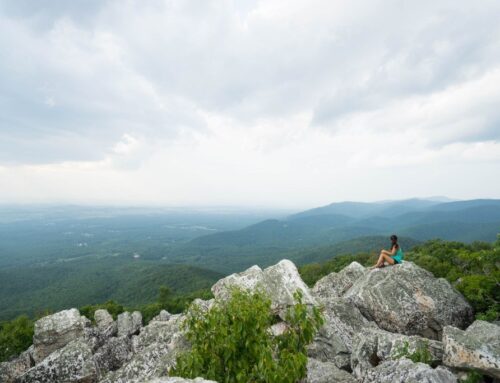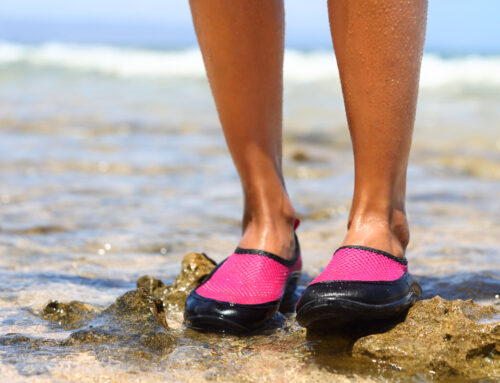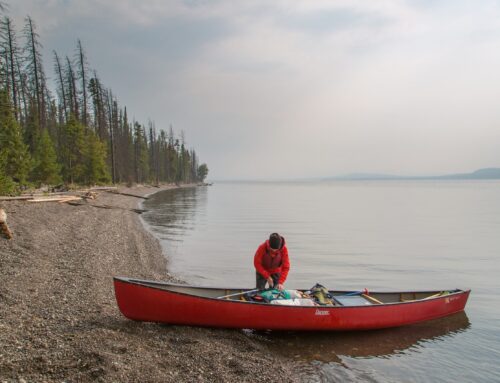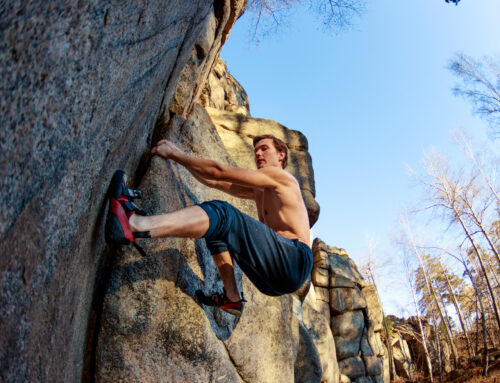Updated July 21, 2021
If you’re anything like us, as the weather warms up and the sun begins to make its debut, you’re probably planning an amazing summer outdoor hiking adventure. And if you are, you know that your gear can make or break any hike, especially when you’re planning to spend most of your free time outdoors. We created this hiking packing list to help you ensure your hike goes as smoothly and safely as possible. If you have the right hiking gear on hand, you’ll stay warm and dry even if you hit a freak thunderstorm or end up in the middle of a trail in the scorching sun. Check out our recommendations for our favorite hiking gear below!

Day Hiking Packing List: Top Essentials for Your Next Adventure
A Sturdy, Lightweight Day Pack
If you’re planning on any longer day hikes, a sturdy, comfortable day pack is a MUST. You’re going to need to carry gear, water, snacks, and extra clothing for those longer hikes, and having a day pack that feels good and distributes weight evenly is absolutely critical. Plus, you definitely don’t want to carry all your stuff in your hands while you’re scrambling up rocks, right?
Your day pack should feel like your best friend and hiking companion. You should look for one that’s spacious enough to hold all of your stuff, but also built to compartmentalize your stuff and distribute weight to your hips, rather than your shoulders.
Our Picks for the Best Hiking Day Packs
For Women: Osprey Sirrus 24
For fearless female hikers, the Osprey Sirrus 24 is the perfect women’s hiking companion (there’s also a larger version here). It’s lightweight but sturdy, with its own frame and ventilation system integrated into the product. For hydration, there’s a pocket for a water reservoir and a mouthpiece holder on the strap.
With several different pockets and straps, holding your stuff is totally intuitive and easy. Plus, it comes with a waterproof cover for sudden rainstorms and other weather conditions.
Check reviews & prices for the Osprey Sirrus 24 on Amazon
For Men: Osprey Stratos 24
For the guys out there, you’ll also want a lightweight, airy backpack that feels like you’re not carrying anything at all. Osprey makes the perfect pack for you as well – the Osprey Stratos 24. (It also comes in a slightly larger 34L version as well!).
It comes with a comfortable hip strap, lots of pockets to organize your stuff, a hydration pack option, and a waterproof rain cover. With a frame and mesh back support designed for ventilation, you won’t have to worry about a sweaty back on warmer hikes.
Check reviews and prices for Osprey Stratos 24 on Amazon
Sweat-Wicking Baselayers
You know the drill: sometimes, you’ll start hiking without a cloud in the sky, and the next thing you know, it’s pouring. Weather can be extremely bipolar – we get it. However, you can be more prepared for any hiking conditions by wearing and bringing the appropriate hiking clothes:
- Waterproof rain shell – We recommend the North Face Resolve Jacket (women’s & men’s)
- Compressible down/synthetic puffer jacket – We love the Patagonia Down Sweater (women’s & men’s)
- Sweat-wicking or moisture resistant pants – Our favorites are PrAna hiking pants (women’s & men’s)
- Thermal layers – Merino wool or synthetic base layers (men’s versions here and here)
- Face cover/dust mask – We recommend the Buff, which doubles as a headband, scarf, and more
- Gloves & a hat (if hiking in cold weather)
Read more: Best Women’s and Mens Hiking Clothes for All Seasons
Hiking Boots & Footwear
Hiking boots are arguably the most important thing you’ll need for hitting the trails, and no hiking packing list would be complete without them! For any kind of hiking excursion, we highly recommend Salomon hiking boots and Keen hiking boots. The right pair should feel like clouds on your feet, while simultaneously being durable, waterproof, and supportive for walking on any kind of terrain.
Hiking Socks
This one is self-explanatory, but you’ll probably want to bring a comfy pair of hiking socks on any adventure. We love Darn Tough wool socks for all of our hikes and mountain adventures. For longer hikes, make sure you choose a pair that’s extra thick for added comfort on your tired feet. If you’re planning on passing through streams or rivers, bring an extra pair in your day pack so you can change into them later.

Reusable Water Bottle
Please don’t be one of those people who hikes with disposable plastic bottles. Do yourself and your environment a favor and use a durable, reusable water bottle instead of single-use plastics. There are loads of different kinds of water bottles out there, but for long day hikes, I always bring my trusty Hydro Flask. It’s solid as a rock and keeps my water cold all day.
Water Purification System
There are all kinds of nasty bacteria, viruses, and parasites lurking in stream water that, if ingested, can make you very sick. If you’re planning on filling up your water bottle along the trails, bring a purification system to make sure you prevent any water-borne illnesses from entering your system.
Some types of filters are better at removing certain kinds of bugs than others, so be sure to do your research and use more than one system to ensure your water is completely safe to drink. When I hike, I use a combination of a water filter and a UV purifier.
Lots of Snacks
There are few things more terrifying than a hangry hiker. If you don’t believe me, just wait until you stumble upon one yourself. If you’re worried about becoming a hangry hiker, make sure you bring lots of snacks and provisions to last you the majority of the day. Some hiker favorites include Clif bars, trail mix, jerky, PB&J sandwiches, and all kinds of fruit (dried and whole).
Solar-Powered Battery Pack
In case of emergencies, you never want to be without some kind of power. A solar-powered rechargeable battery pack can help with this. Just hang it on the back of your backpack while hiking and it will recharge automatically. Then, if you need to recharge your phone, GPS, camera, or something else, you can do so on the trails.

Head Lamp
Sometimes, the best times to hike are in the early morning and late in the afternoon. Those mountain sunrises/sunsets are calling! However, if you plan to hike in non-optimal daylight, it’s critical to bring a head lamp with you. Head lamps make it easy for you to navigate around in the dark without needing to hold on to something extra. We love the Black Diamond Spot head lamp for our hiking excursions.
I recommend bringing a head lamp on every hike in case of emergencies, as you never know whether you might get lost, face severe weather conditions, or otherwise need to set up camp somewhere unexpectedly.
Trekking Poles
You may not need trekking poles for every single adventure, but for longer or more difficult day hikes, you’ll definitely want a pair you can stash away for use when you need them. For this, we use and recommend the Black Diamond Distance Carbon Z Trekking Poles – they’re a bit of an investment, but we love how packable, portable, and lightweight they are for any trip or adventure.
Sunglasses
If you’re outdoors for more than a few minutes, you should definitely make sure you’ve got a good pair of sunglasses. However, not all sunglasses are created equal. You can best protect your eyes by thoroughly researching each pair of sunglasses, ensuring they have adequate UV protection, and making sure they’re polarized. For hiking, you may want to purchase a lanyard as well to make sure your sunglasses don’t fall or get lost.
Sunscreen and Hat
Sun protection for your skin is just as important as sun protection for your eyes. On any hike, you should have adequate amounts of sweat-resistant sunscreen and reapply it regularly. If you’re going to be swimming in the ocean or nearby, I recommend using some reef-safe sunscreen to help protect marine wildlife. Some UV protecting lip balm is also a good idea.
To protect your face, you should also use a sweat-resistant brimmed hat (preferably with a drawstring, so that it doesn’t fly away in the wind).

Bug Spray
No one likes bug bites. They’re itchy, unsightly, and a nuisance. But more importantly, some kinds of bug bites can cause horrible diseases (like malaria or Lyme disease) and long-term bodily damage. Therefore, it’s critical to protect yourself from mosquitoes, ticks, and spider bites as much as possible. When hiking any distance, be sure to bring bug spray with DEET for maximum protection.
Emergency Blanket
If you do end up getting stranded overnight (or even during the day), an emergency blanket is a must. It will help to keep you warm and dry, and provide a small bit of shelter from the elements. Sure, you probably won’t use it 99% of the time, but it’s a good idea to carry one with you in case the unexpected happens.
First Aid Kit
There’s no need to bring a bulky, unwieldy first aid kit on your day hikes. However, you should have a small, basic kit on all of your hikes. I find it easiest to buy a pre-assembled first aid kit, which includes a small bag to hold everything.
Regardless, any kit you bring should include the following items (at a minimum):
- Adhesive bandages
- Antiseptic wipes
- Antibiotic cream
- Alcohol swabs
- Bandage wrap
- Gauze and tape
- Gloves
- Basic medications – antihistamine, ibuprofen, acetaminophen, aspirin, antacid

Additional Bonus Items for Day Hiking
These items aren’t an absolute must for day hikes, but you’ll probably want to bring them anyway:
- Toilet paper
- Wet wipes
- Hand sanitizer
- Bear/pepper spray
- Binoculars for wildlife watching
- ENO Double Nest Hammock
- GPS system
- Watch
- Camera
- Stove and camping meals
Additional Resources
- 55 Inspiring Hiking Quotes to Fuel Your Next Adventure
- 35 Totally Genius Gifts for Hikers (That They’ll Actually Use)
Did you like this post? Pin it for later!











